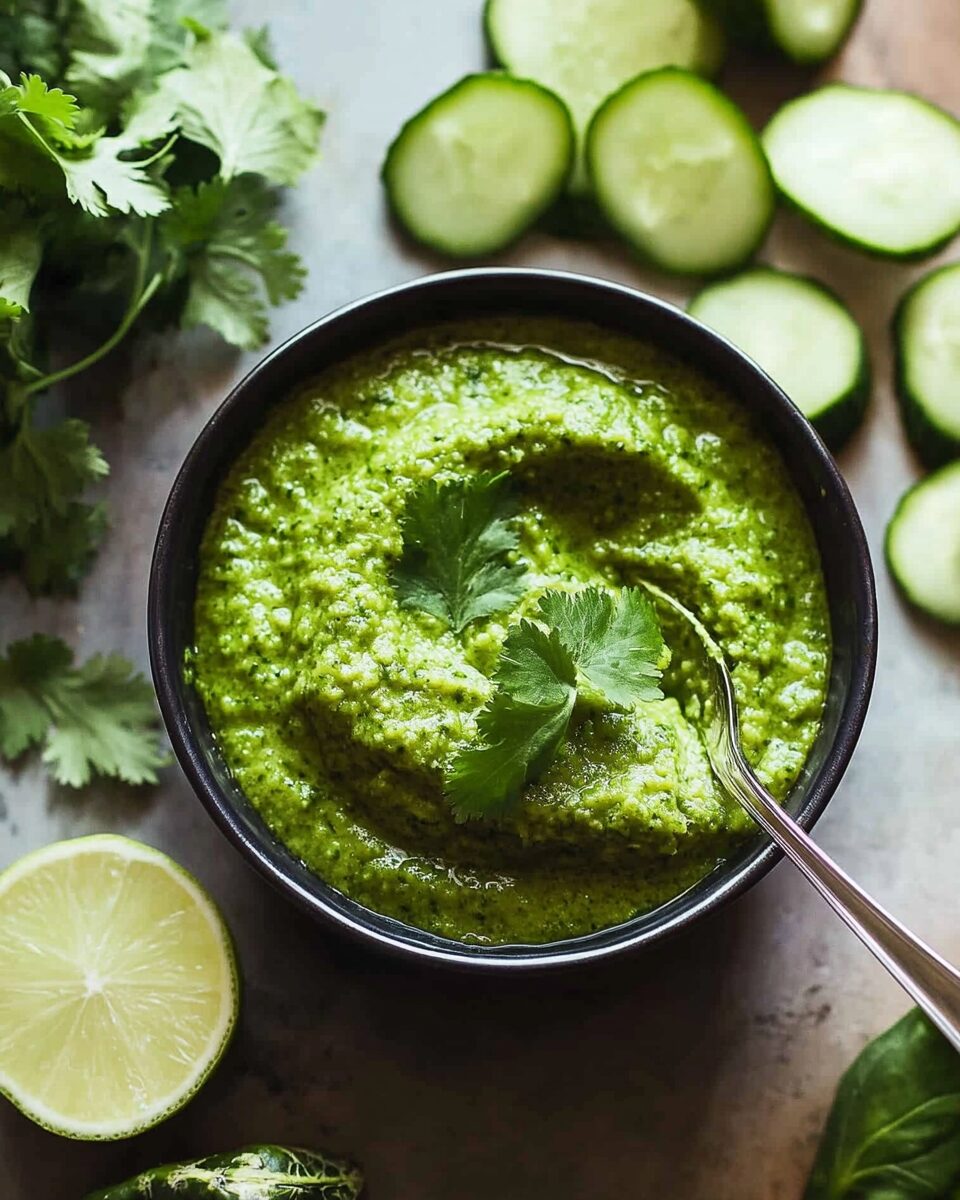Thai Green Curry Paste is the backbone of one of Thailand’s most famous and delicious curries. This homemade version brings together the authentic flavors of fresh chilies, lemongrass, galangal, and herbs, creating a paste that is bursting with fragrance and heat. With just a few minutes of preparation, you can achieve restaurant-quality curry right in your own kitchen.
This versatile paste can be used in a wide variety of dishes, from classic green curry to marinades, soups, and stir-fries. Making it yourself ensures that you control the freshness and quality of the ingredients, making it a healthier and tastier alternative to store-bought versions. Whether you’re cooking for family or impressing guests, this Thai Green Curry Paste will elevate your dish to the next level.
Full Recipe:
- 10 small green Thai chilies, chopped
- 1 large green chili, chopped
- 1 tablespoon lemongrass, finely chopped
- 1 tablespoon galangal, finely chopped
- 1 tablespoon ginger, finely chopped
- 2 cloves garlic, chopped
- 1 small onion or shallot, chopped
- 1/4 cup cilantro stems
- 1 teaspoon ground cumin
- 1 teaspoon ground coriander
- 1/2 teaspoon white pepper
- 1 tablespoon shrimp paste (or miso paste for vegetarian/vegan)
- 1 tablespoon fish sauce (optional, omit for vegan)
- 1 tablespoon lime juice
- 2 tablespoons water (to help blend)
Directions:
- In a food processor or mortar and pestle, combine the green Thai chilies, green chili, lemongrass, galangal, ginger, garlic, onion, and cilantro stems.
- Add the cumin, coriander, white pepper, shrimp paste, and fish sauce (if using).
- Blend until you get a smooth paste, adding water as needed to help it come together.
- Stir in lime juice and adjust seasoning to taste. The paste should be fragrant, spicy, and slightly tangy.
- Store in an airtight container in the refrigerator for up to 2 weeks, or freeze in portions for future use.
Prep Time: 15 minutes | Total Time: 15 minutes
Kcal: 25 kcal per tablespoon | Servings: Makes about 1/2 cup paste
Thai Green Curry Paste: The Heart of Authentic Thai Cuisine
Thai cuisine is renowned for its bold flavors, intricate balance of sweet, salty, sour, and spicy, and the remarkable freshness of its ingredients. At the heart of many Thai dishes lies the humble yet powerful curry paste, a flavor bomb that embodies the essence of Thai cooking. Thai green curry paste, in particular, is one of the most popular and versatile, bringing a vibrant punch to dishes with its fragrant herbs, spicy chilies, and earthy spices.
Green curry paste is the foundation for the famous Thai Green Curry (Gaeng Keow Wan), but it can be used in various other dishes, from marinades to stir-fries, soups, and dips. Making your own curry paste at home ensures that you get the freshest flavors, without the preservatives or additives that often accompany store-bought versions.
The Origins of Thai Green Curry Paste
Thai green curry paste has roots that can be traced back centuries, deeply embedded in Thailand’s cultural and culinary history. It is believed to have originated in Central Thailand, where the combination of fresh herbs and spices was perfected. Thailand’s warm, tropical climate provides the ideal environment for growing the key ingredients, such as Thai chilies, lemongrass, and galangal, making them abundant and accessible in traditional Thai kitchens.
The term “green curry” comes from the vibrant color of the paste, derived from the fresh green chilies used in its preparation. Green curry is generally milder compared to its red or yellow counterparts, but it still packs a fiery punch, especially depending on the type of chilies used.
Key Flavor Components of Thai Green Curry Paste
Each ingredient in green curry paste plays a crucial role in creating the paste’s complex flavor profile. Below are the key flavor elements that make this paste a cornerstone of Thai cuisine:
- Green Thai Chilies: These small, fiery chilies provide the signature heat for green curry paste. The combination of these chilies with larger, milder green chilies ensures a bright, spicy kick without overwhelming the palate.
- Lemongrass: This aromatic grass adds a fresh, citrusy note to the paste, balancing the heat from the chilies. It is often pounded or finely chopped to release its oils and flavors.
- Galangal: A cousin of ginger, galangal adds an earthy, spicy undertone with a hint of pine. It is essential for adding depth to the paste.
- Garlic and Onion: These provide a savory base for the paste, enhancing its overall richness and complexity.
- Cilantro Stems: While many cuisines focus on the leaves, Thai cooking makes full use of cilantro stems, which have an intense flavor and help brighten the paste.
- Spices: Ground cumin, coriander, and white pepper add an earthy, slightly smoky dimension to the paste, giving it a rounded warmth.
- Shrimp Paste: This fermented seafood product is a key element of traditional green curry paste, adding umami depth. However, for those following vegetarian or vegan diets, it can be substituted with miso paste or omitted altogether.
The Art of Balancing Flavors
Thai cuisine is all about balancing the five primary taste profiles: sweet, salty, sour, bitter, and umami. Thai green curry paste is no exception. Here’s how these elements play into the final paste:
- Spicy: The heat from the chilies is unmistakable, but it’s tempered by the other flavors, making the spice tolerable for most.
- Salty: Shrimp paste and fish sauce (if used) add saltiness, which can be adjusted depending on your personal preference.
- Sour: Lime juice brings a tangy brightness to the paste, helping cut through the richness of the other ingredients.
- Umami: Shrimp paste provides that savory, umami flavor, crucial for creating depth in the paste.
- Bitter: Though subtle, the slight bitterness of the cilantro stems and galangal offers complexity, keeping the paste from becoming one-dimensional.
Why Make Thai Green Curry Paste at Home?
While it’s easy to find pre-made curry paste in stores, there are several reasons why making your own from scratch can be a game-changer:
- Freshness: Store-bought curry pastes often contain preservatives, which can dull the flavors over time. When you make it at home, you use fresh ingredients, ensuring the brightest, most vibrant taste.
- Customization: By making your own curry paste, you have full control over the ingredients. Want it spicier? Add more chilies. Prefer a vegan version? Skip the shrimp paste and fish sauce. You can also adjust the seasoning to suit your taste.
- Healthier: Homemade curry paste is free from artificial preservatives, additives, and excess sodium, making it a healthier choice for those watching their diet.
- Cost-Effective: Making curry paste at home is surprisingly economical, especially if you make a large batch and freeze portions for later use.
- Sustainability: Using fresh, local, and organic ingredients can be a more environmentally friendly option, reducing the carbon footprint associated with processed, packaged products.
Practical Tips for Storing and Using Thai Green Curry Paste
One of the best things about homemade curry paste is its versatility and shelf life. Here are some practical tips for storing and using your green curry paste:
- Storing in the Refrigerator: Homemade green curry paste can be stored in an airtight container in the fridge for up to two weeks. The paste may darken slightly over time, but the flavors will remain robust.
- Freezing for Later: Green curry paste freezes beautifully. To freeze, spoon the paste into ice cube trays and freeze. Once frozen, pop the cubes into a freezer bag for easy portioning. Frozen curry paste can last up to six months.
- How to Use: Green curry paste is most famously used in Thai green curry, but its uses extend far beyond this classic dish. You can stir it into coconut milk for a rich, flavorful base for soups or sauces. It works wonders as a marinade for chicken, fish, or tofu, or as a base for stir-fries. You can even add a spoonful to dips and dressings to give them a spicy, exotic twist.
Dishes That Use Thai Green Curry Paste
Once you’ve made a batch of green curry paste, you’ll find that it opens up a world of culinary possibilities. Here are a few dishes where you can make the most of this flavorful paste:
- Classic Thai Green Curry (Gaeng Keow Wan): Combine green curry paste with coconut milk, your choice of protein (chicken, tofu, or shrimp), vegetables, and Thai basil for a creamy, flavorful curry that’s perfect over jasmine rice.
- Green Curry Fried Rice: Add a spoonful of green curry paste to your fried rice for a spicy, aromatic twist.
- Grilled Chicken with Green Curry Marinade: Use green curry paste as a marinade for chicken before grilling. The herbs and spices in the paste will permeate the meat, resulting in juicy, flavorful chicken.
- Green Curry Soup: Whisk green curry paste into a pot of coconut milk or vegetable broth for a comforting, spicy soup. Add vegetables like baby corn, zucchini, and mushrooms for texture.
- Vegetable Stir-fry with Green Curry: Stir-fry your favorite vegetables with green curry paste and a splash of coconut milk for a quick and easy dinner.
The Cultural Importance of Green Curry in Thai Cuisine
Green curry holds a special place in Thai culture. In traditional Thai meals, curries are often served alongside other dishes, such as stir-fries, soups, and salads, as part of a communal meal. The harmony of different flavors is central to Thai cooking philosophy, and green curry exemplifies this balance of spicy, sweet, and creamy.
Green curry is often prepared for special occasions or gatherings, symbolizing warmth and hospitality. In Thailand, food is more than just sustenance—it’s a form of communication, a way to express love, and a bridge that connects people. Preparing and sharing a meal like green curry is a cherished tradition, passed down through generations.
Conclusion
Thai green curry paste is a cornerstone of Thai cooking, delivering bold, complex flavors with minimal effort. By making it at home, you’re not only ensuring the freshest and healthiest ingredients but also embracing a tradition that has been part of Thai culture for centuries. Whether you’re a seasoned cook or new to Thai cuisine, homemade green curry paste offers a versatile and flavorful addition to your culinary repertoire.
Making your own green curry paste is easy, rewarding, and offers endless possibilities for delicious meals. From classic curries to creative marinades and stir-fries, the bold, fragrant flavors of this paste will transport your taste buds to the vibrant streets of Thailand.






